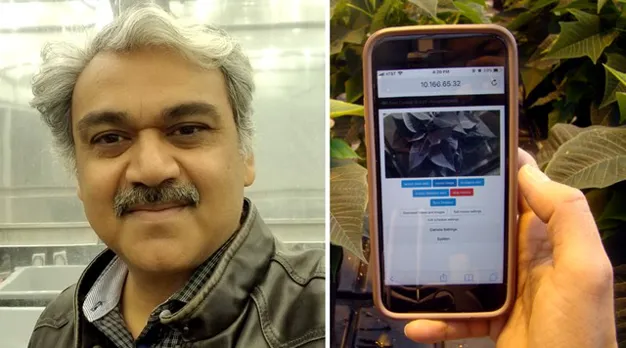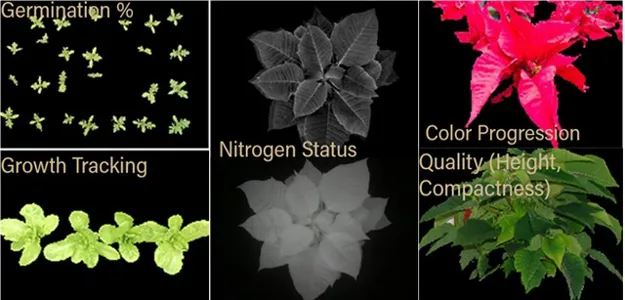With a mission to deliver easy-to-use, rapid, and affordable technologies to the controlled environment agriculture (CEA) industry, Dr. Krishna Nemali and his research group at Purdue University are tackling crop-monitoring challenges facing hydroponic and flower growers. Of the group’s many research foci, image-based crop monitoring using smartphones and microcontrollers has been at the forefront of Purdue’s technological advancements for the CEA industry.
Image-based crop monitoring made practical and affordable
Image analysis is being used for monitoring plants in conventional, field-based agriculture through satellites, drones, and camera-mounted vehicles. However, these technologies are not practical for greenhouses and indoor farms due to the architecture of these facilities, which limits the movement of drones or camera-mounted vehicles over plants. Dr. Nemali and his research group are working to bring image-based crop monitoring on smartphones as handheld sensors. For installations where using cameras fixed to the growing systems is preferred (e.g. vertical farms with multi-tiered racking) or applications where continuous monitoring is useful, the research team is also building a system with a Raspberry Pi microcontroller and high-resolution camera, which sends the images to a central computer for processing and interpretation.
 Left: Dr. Krishna Nemali. Right: smartphone sensor
Left: Dr. Krishna Nemali. Right: smartphone sensor
Compared image-based monitoring to human evaluation
To test the efficacy of image-based crop monitoring, the research team grew lettuce and tomatoes under optimal and suboptimal conditions. In a blind trial, crop growth was visually evaluated daily by people (using a rating system) and by image-based sensors. As Dr. Nemali explains, the image-based system recorded statistically significant differences in crop growth between optimal and sub-optimal conditions 3-4 days before the human eye could detect differences.
“When you regularly take these photos and develop growth curves, you can monitor how your crop is measuring up against expected optimal growth. If these images indicate an issue, growers can resolve this before it is too late,” says Dr. Nemali.
The images can also be used to assess nitrogen status, germination percentage, and rate, and color progression, allowing the grower to monitor crop health, planting material, and estimate the time to harvest. Plant nitrogen status is usually measured in a laboratory, which is expensive and time-consuming or using expensive chlorophyll meters. Dr. Nemali’s research developed accurate algorithms using images captured by smartphones and microcontrollers to rapidly estimate plant nitrogen status.

Different plant measurements can be measured using images collected by a smartphone or microcontroller
Instantaneously assessing plant nitrogen
“Imaging the benefits of instantaneously assessing plant nitrogen status in CEA industry. Growers can supply fertilizers based on plant needs and avoid over or under application rates,” says Dr. Nemali
As these technologies are being developed at Purdue University, they will be made available to growers at a low cost, with any generated funds being poured back into further research and development. The smartphone app should be available in the spring of 2022, with a low purchase price and yearly license.
With photo quality varying according to the camera, ambient light conditions, and distance from the crop, normalization processes have been incorporated into algorithms to ensure high-quality analyses. To account for differences in distance from the crop between imaging sessions, each photo is taken with a standard, measured object in the frame.
“Let’s say we have a red square with a known area of 25 cm2 and we place it beside the crop in each image. The computer will recognize that object, uses its area to determine the right pixel-area conversion and apply it to the plant. This creates a relative scale and eliminates height/distance altogether,” says Dr. Nemali.
To normalize for different light conditions, the technology considers different reflected wavelengths, both of which are affected by light intensity. By taking the ratio of two wavelengths, the setup can eliminate the effects of light intensity on the images altogether.
A demonstration of smartphone-based image technology can be viewed on Dr. Nemali’s website at this link.
Additional areas of research
Aside from image-based crop monitoring, Dr. Nemali’s research group is conducting extensive research on nitrogen management in hydroponically grown organic lettuce production.
“The yields of organic lettuce is usually lower compared to conventional production, because of challenges with nitrogen availability to plants in organic production. While organic lettuce does command a higher price, we still need to increase these yields to make it sustainable and organic produce more available to consumers,” explains Dr. Nemali.
Other areas of research include the use of ultraviolet radiation and ozone to reduce the risk of E. coli contamination in lettuce, and the optimization of production techniques to improve the nutritional density of leafy greens.
For more information on ongoing research in Dr. Nemali’s research group:
Dr. Krishna Nemali
Assistant Professor in Controlled Environment Agriculture
Purdue University
https://www.purdue.edu/hla/sites/cea/
